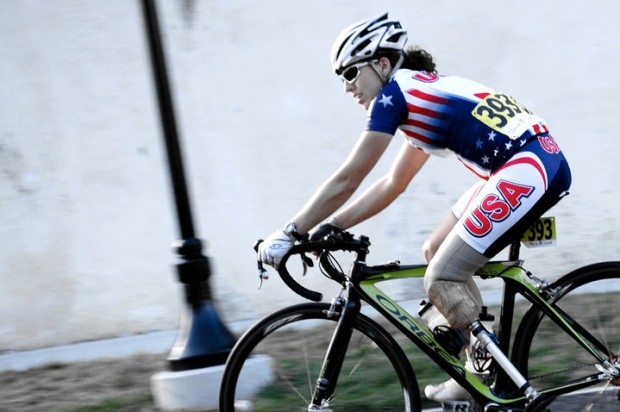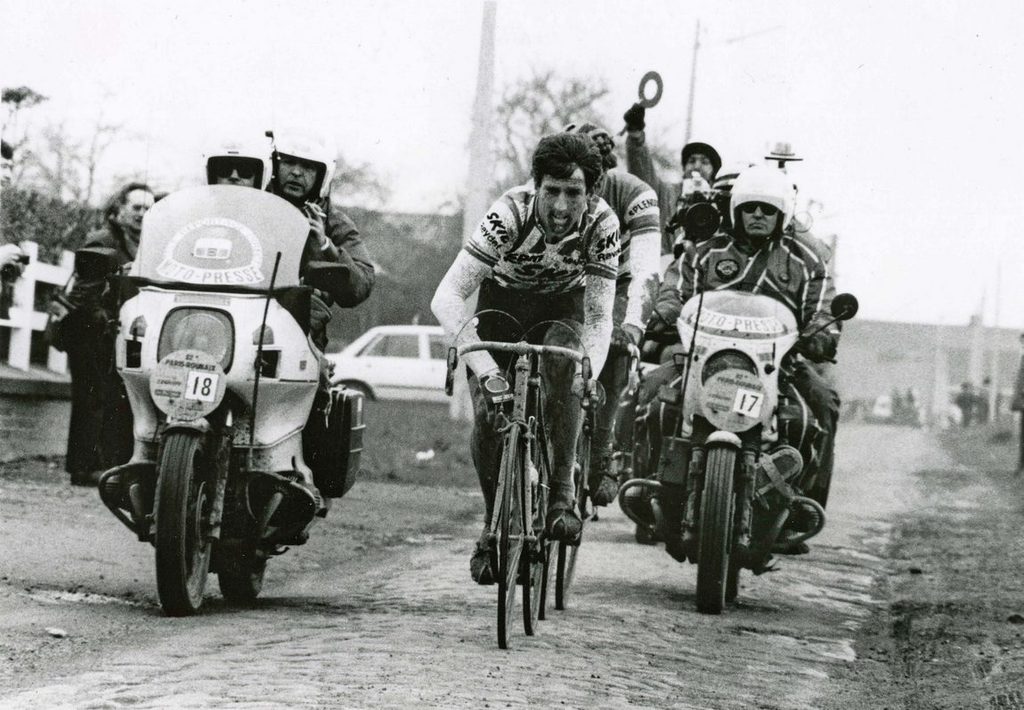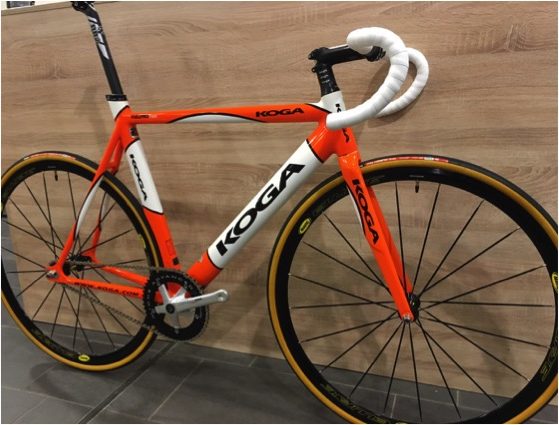Guest Article: The Fine Art of Pedaling

Keeper Jim and I came across Meg Fisher during an icy-rain Rule #9 training ride on Mercer Island in March. The first thing that struck us was that there was a good rider up the road, one of the few braving those cold, wet, early morning hours. It wasn’t until we caught up to her that we realized she was riding with a prosthetic leg.
The three of us got to chatting the way cyclists do, and every time Meg went to the front to push the pace or got out of the saddle to grind over a roller, I was amazed to see how ‘normal’ her pedaling action was. Apparently, it didn’t come naturally or quickly, and after starting a conversation on prosthetic pedal stroke magnificence, Meg has graciously agreed to contribute a complete article to this geekery.
In the meantime, she’s joined our community (and reformed in her Rule #37 violating ways). Meg now actively blogs on her Tumblr and has also set up a donation fund to help her with upgrading her prosthetic (can you say ‘carbon’?) and getting her to the 2012 Paralympic Games. Please donate if you’re willing and able.
Yours in Cycling,
Frank
—
Pedaling with one leg and one peg-leg (that vaguely resembles a pipe bomb) has presented some challenges.
In an attempt to make all of this as clear as possible, I am going to share some basic facts about prosthetics. A “socket” is the carbon piece that is shaped like a cup. This is the part of the prosthetic that encases what remains of someone’s limb; for me it covers my knee. The “pylon” is a vertical piece of pipe, usually made of aluminum, that connects the socket to the “prosthetic foot.” All prosthetic feet are made from carbon. The stiffness or rigidity of each foot is based on how many layers of carbon are used and how they are laminated. I assume that you all are experts on carbon!
Personally, I like super stiff feet. A stiff foot moves less and, in my opinion, is more predictable. To help you all get the idea of what it might be like to have a prosthetic leg, imagine walking with one foot in a ski boot. Soft feet feel like you are walking in soft sand. Medium feet feel like you are walking on a loose gravel trail. Stiff feet feel like you are walking on concrete. They do not give unexpectedly but are somewhat less forgiving.
Back in the day, before I received my specially adapted biking prosthetic (the pipebomb), I rode using my everyday prosthetic in a typical cycling shoe. I used this set up for several years when I primarily raced mtn bikes and off-road triathlons. I vaguely recall feeling some low back pain and right knee pain from back then. In an attempt to alleviate the pain from my prosthetists, John Angelico & David Rotter with Scheck & Siress Orthotics & Prothetics, designed my current cycling leg. I went into their office with my bike on a trainer and asked them how they could help me look more “normal” on a bike. The owner and master bike fitter of Missoula Bicycle Works, Alex Gallego, had given me some advice to pass on to my prosthetists. John and David basically mounted a heavy-duty aluminum pylon with a carbon prosthetic foot to my socket. After experimenting with pylon length and cleat placement, we discovered how best to compensate for my missing ankle.
Fundamentally, I rode like someone who had an exceptional leg length discrepancy. When I rode with my everyday prosthetic leg, it lacked the biomechanics inherent in intact ankles. During a pedal stroke with an intact ankle, there is plantar flexion & dorsiflexion. Since I could not accomplish these movements with my prosthetic, I had to compensate by shifting on my saddle and changing my biomechanics everywhere. Observers could clearly see my hips and lower back shifting dramatically during every pedal revolution. I had to set my seat post height high enough so that I would not pinch the back of my left knee during the top of the pedal stroke. If my seat height was too low, I developed blisters on the back of my knee that could be so bad that I literally could not walk the next day. I also wanted my seat height low enough so that I could reach the bottom of the pedal stroke. Usually, people with a leg length discrepancy would not develop blisters on the back of their knee. However, they may notice difficulty reaching the bottom of the pedal stroke and observers may see compensatory motions in the low back.
My prosthetists mounted the cleat under what would be my heel. They also made the pylon a bit longer than my shin on my other leg. These adjustments allowed me to reach the bottom of my pedal stroke and keep my seat height high enough to relieve pressure on the back of my knee. By using a specially designed cycling prosthetic, I became better able to keep my hips ‘quiet’ on my saddle.
Still, as I up’d my mileage and continued training with the National Paracycling Team, I continued having low back pain, right knee pain, and severe pain in the right hip. It was deep pain inside the front of my right hip. It felt like someone was driving an icepick into my joint capsule. The only time it felt better was when I was laying flat on my back. Sitting with my hips near 90 degrees caused intense pain. I managed to make it through the season and competed at the UCI Para World Championships in 2010. Somehow, I squeaked out a win in the time trail (even after starting ~40sec late) and the road race. I thought wining two world championship rainbow jerseys would be the end of my cycling career. In the off-season, I went to physical therapy and the prognosis looked bleak.
That’s when Brian Williams, my friend and talented Cat 1 rider, came up with the idea of shortening only my left crank arm. Brian explained that for most individuals with a leg length discrepancy, using two different length crank arms does not alleviate their symptoms. So I called SRAM and explained my situation and Brian’s idea. SRAM generously sent me a 165mm left crank arm at NO CHARGE! Brian installed my new crank arm and set me on a road to recovery.
I have been riding with my shortened left crank arm for a while now. The pain in my right hip is gone and my lower back pain is under control. Initially, the difference in crank arm lengths did feel funky. However, I quickly adapted and will never go back. I have not had anyone measure the strength or power generated by my left leg. If you ever saw me in spandex, you could quickly see that my right side much bigger than my left. I am continually refining my pedal stroke. It has come so far and there is still room for improvement. At times, I feel like my left leg is sabotaging the work of my right leg. Maybe I should just cut the rest of it off?!
At the end of the day, I am just like you. I get on my bike and try my best to ride fast and keep the rubber side down. With any luck and a whole lot of effort, I will earn a spot on this year’s US Paralympic Team going to London. Keep your fingers and toes crossed for me. I could use all the luck in the world.


@frank
Prosthetics have several possible methods for attachement- this is referred to as “suspension.” As in “What kind of suspension system do you use with your prosthetic?”
That is an excellent question. I use a urethane suspension sleeve with a silicon liner and a one-way valve. I wear the liner against my skin on what remains of my limb. I cringe at the word “stump.” So, if anyone uses it, be prepared to get kicked in the nuts. Residual limb is acceptable. Okay… where was I?? Ah yes, the liner. The silicone liner acts as a bit of cushioning between my body and the hard carbon socket. Kind of like a sock might do on your foot. My residual limb rests inside the socket like a foot inside a shoe. The socket is painstakingly crafted to fit me perfectly. I can run, jump, ski and bike using the exact same socket. To keep my limb inside the socket, I use the suspension sleeve. You can easily see the suspension sleeve on the photos above. The sleeve is attached to the socket and then rolls up my thigh. The sleeve is snug and when it comes in contact with the skin of my thigh, it creates an air-tight seal. Basically, the environment between my socket and my thigh becomes sealed. Think of a gaiter you might use when hiking or skiing. The gaiter attaches to your shoe and then goes up your leg and prevents anything from getting in your shoe.
Here’s the coolest part. There is a one-way valve at the bottom of my socket that allows air to leave my socket and air-tight environment but not re-enter. So that means that the air-tight environment becomes practically vacuum sealed. How awesome is that ?!! When all systems are working, my prosthetic moves in perfect harmony with my body.
As it relates to cycling, my left side is primarily used to push down on the pedals. Only ~5 inches remains of my left leg. With such a short lever arm, I cannot generate much force to sweep across during the bottom of the pedal stroke. The Achilles Heel (if you’ll pardon the pun) of my suspension system is sweat. If my thigh starts to sweat, I cannot pull up on my prosthetic because it will slide right off.
Does this answer your questions Frank?
@MegFisher Thanks for a great article and taking the time out of your busy training schedule to explain the mechanics of your stroke. I found it particularly interesting about the stiffness of the carbon in the foot and the associated feeling that generates when using it and also the position of your cleat. I spent many months making adjustments on my cleats to find the right position and there is a difference relatively between my left and right. I am a Londoner but I have to say I will be cheering you on to victory on the day. I will also be passing your details around my office to try and get as many donations as possible as well as finding something useful to put on that internet monstrosity facebook. I don’t know if you have tried but you may well want to drop an email to Lockheed Martin press department as companies like them have all the equipment and know-how to make what you need and might be interested in helping as the “marketing win” would no doubt interest them. A formula one company did something similar over in blighty. As well as donations that are no doubt flowing in from the Velominatus all over the world, if there are any other things we can help with please let us know. We are a very varied bunch and who knows how we might be able to assist.
The only question I do have is about weight differences between competitors, has the UCI in professional cycling and the olympics board set any kind of minimum weight level after which sandbags :o) or something are added. Also is the prosthetic made as light as possible or does it have to have a certain weight in order for you to feel balanced on the bike?
You are awesome, Meg.
Meg, you need to join us on the Seattle Summer Cogal. I need someone’s wheel to suck. See you there? Or will you already be in London on 6/16?
@MegFisher
That is so cool; there are some seriously clever people about, thinking over these serious problems and coming up with really elegant solutions. That is so cool. Suction! It’s inspired, but so incredibly simple and obvious.
@eightzero
Seconded, if you can work it into your training plan, you should join us for sure. Cheers!
Deep respect!!!
Damn, total bad ass story. Fantastic. Awesome to see what determination and technology can do – allow you to ride. And just ride, really ride. Great stuff…
Hi, am also a LBKA cyclist. Thanks for this article. I have already discovered a great deal of this through my own trial and error, but was curious about one aspect. It has been suggested to me to be rid of the “foot” on that side as well, but I have enough trouble releasing from the cleat WITH the leverage of the foot. How are you able to twist your knee enough to disengage the cleat while riding?
@M Jordan
It is much tougher for amputees to gracefully disengage from their cleats on their affected side for the reason you stated- it is hard to generate enough torque to overcome the cleat/pedal connection. I’m not sure what type of pedals you run on your prosthetic side. I have been using a Shimano XTR Spd pedal on my prosthetic side and a Speed Play on my sound side. I think I can hear everyone groan at the mention of a mountain bike part on a road bike. Suck it up fellas. I used a mtb pedal for various reasons. Primarily because it is what I had to work with, it has dual entry, and the tension is easily adjustable. I found that I can get into the spd pedal quickly and, if I set the pedal’s tension as loose as possible, that I can get out easily.
I am not concerned about my foot accidentally disengaging from my pedal. In most circumstances, I hardly use my left leg (except to push down on my pedal).
I hope this helps. Let me know if you have more questions.
Seriously you get a pass for rule violations. And at least it’s XTR! Gear snobbery can be preserved.
@MegFisher
I remember when you got a flat on I90, you got off on your sound side and unclipped on the prosthetic side. I didn’t think much of it at the time, but it was very clean how easily it seemed to clip out. I can also imagine that you don’t unclip easily while riding as I imagine there’s less movement in the system than with a natural leg.
Going with one MTB pedal is as inspired as going with a shorter crank length. Its inspired!
An interesting story posted today on the NYTimes website which relates a little to the topics covered here.
Great news: Meg has made the Olympic team and is headed for London.
She’s moving to the Olympic Training Center in Colorado Springs at the end of the month to focus on training. At the end of August, the Team is going to London. Races start on August 30th. She’ll be racing in the 500m TT & 3k pursuit on the track and the road TT and road race.
Congrats!
I’ve been watching her progress on Facebook. What an amazing woman!
@frank ahh, just found this second article. I posted something on the first one about her making the team.
Will definately be following her progress.
Meg’s not in any of these photos, but there are a couple of other cyclists. All of these athletes are inspiring
http://www.theatlantic.com/infocus/2012/08/preparing-for-the-2012-paralympics/100361/
@seemunkee
Incredible — heavy V!
Meg won silver in the Individual Track Pursuit.
Chapeau Meg!
@motor city According to the Paralympic website Meg is also racing in C4 Time Trial on Wednesday and the C4-5 Road Race on Thursday.
Team GB favouritism aside, GO MEG!!
Can you give the differential from the left to riight leg. I’m a symes amputee, left. I’m wanting to do road biking. But I need the help of what spd’s I need. I’ve been riding horses and motorcycles for years. Any wisdom on what to do on a Modano 6.2 as far as pedals and the crank would be greatly appreciated.
I know this site provides quality depending content and other
stuff, is there any other web page which provides such
data in quality?